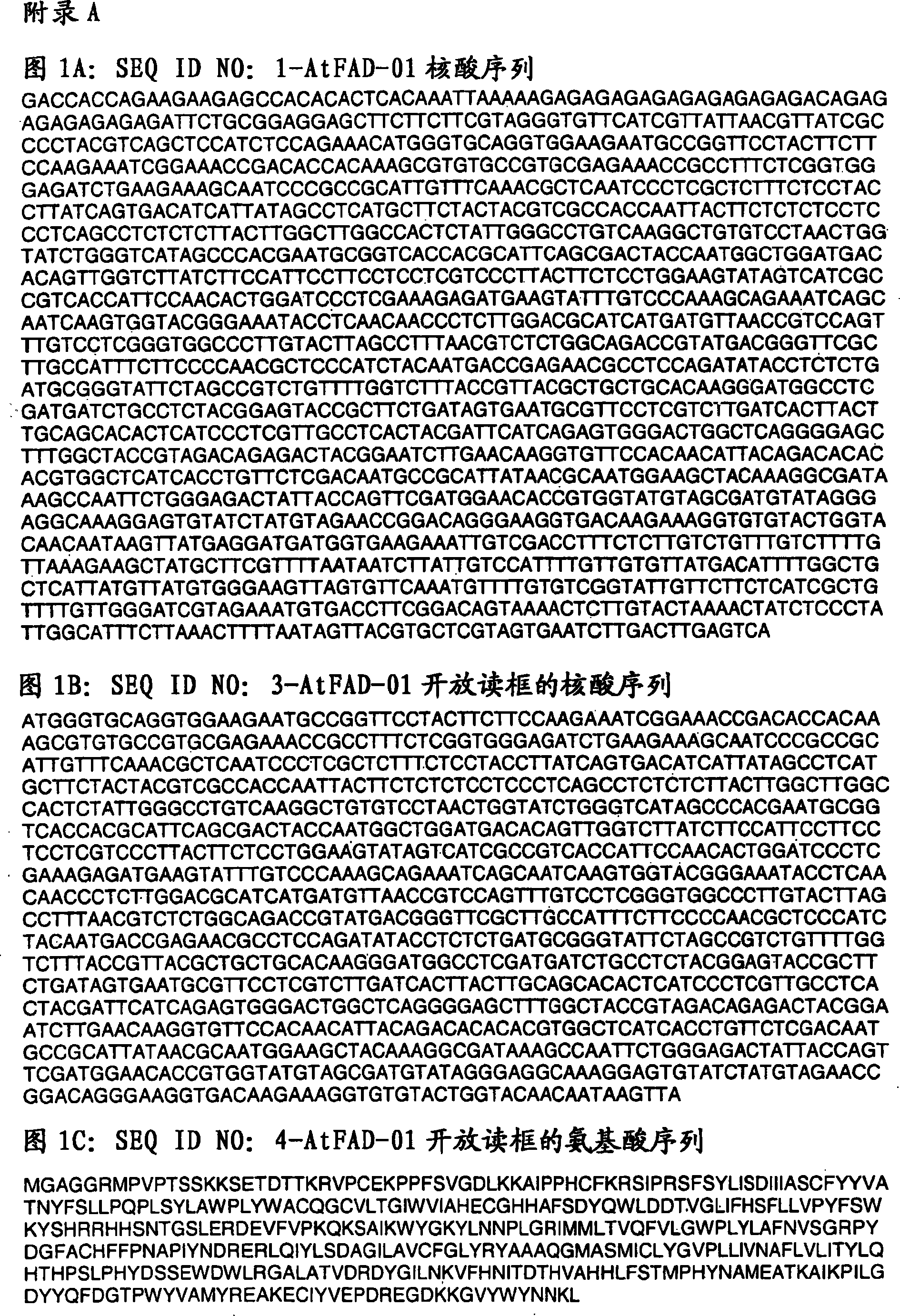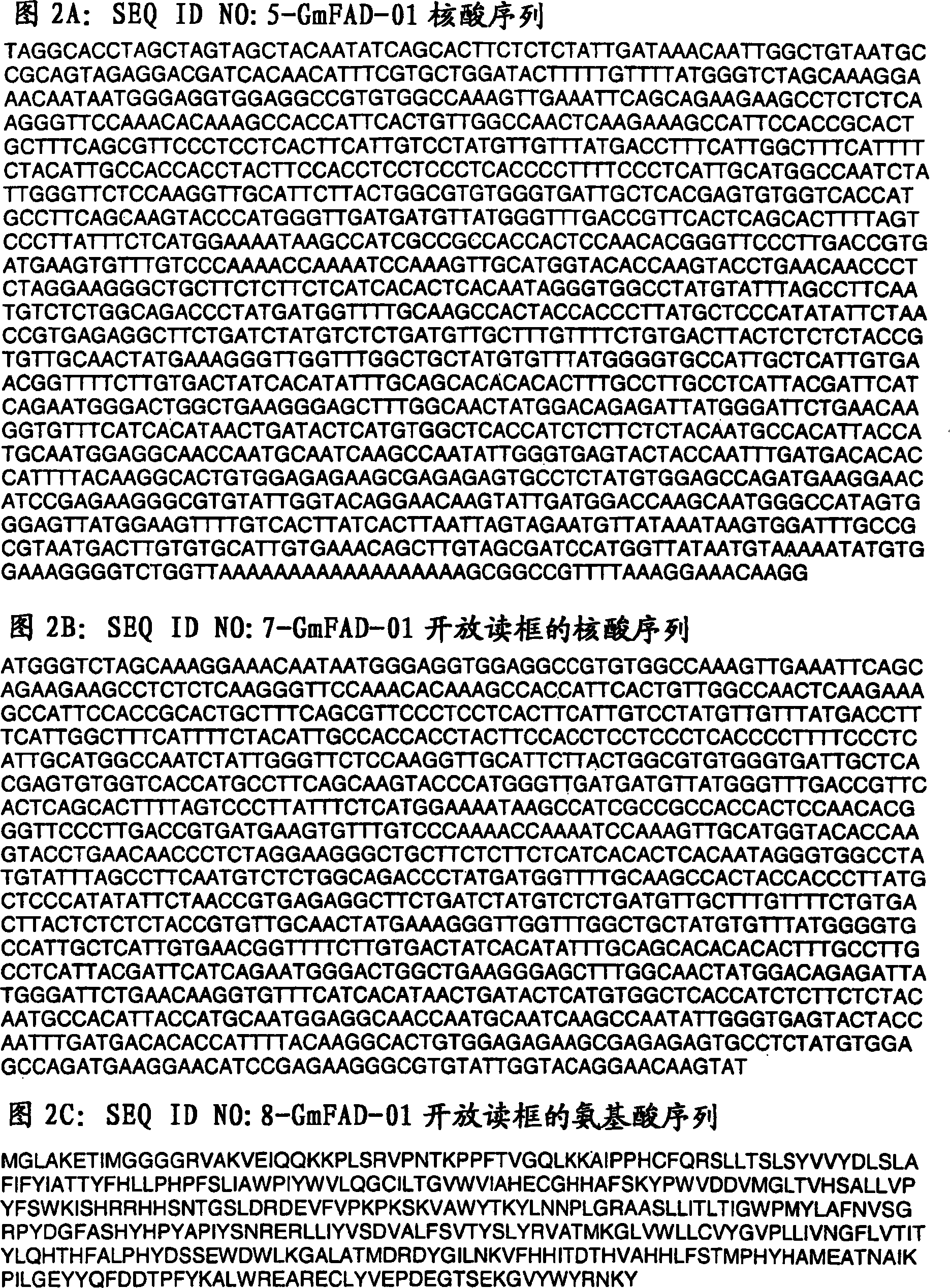Nucleic acid molecules encoding fatty acid desaturase genes from plants and methods of use
A nucleic acid, coding technology, applied in the fields of botanical equipment and methods, biochemical equipment and methods, plant products, etc., can solve problems such as reducing the risk of heart disease
- Summary
- Abstract
- Description
- Claims
- Application Information
AI Technical Summary
Problems solved by technology
Method used
Image
Examples
Embodiment 1
[0266] Example 1: General steps
[0267] a) General cloning steps:
[0268] According to Sambrook et al. (1989, Cold Spring Harbor Laboratory Press: ISBN 0-87969-309-6) or Kaiser, Michaelis and Mitchell (1994, Methods in Yeast Genetics, Cold Spring Harbor Laboratory Press: ISBN 0-87969-451-3) Cloning steps such as restriction cleavage, agarose gel electrophoresis, purification of DNA fragments, transfer of nucleic acids to nitrocellulose and nylon membranes, ligation of DNA fragments, transformation of Escherichia coli and yeast cells, bacterial growth, and preparation of recombinant DNA Sequence analysis.
[0269] b) Chemical substances:
[0270] Unless otherwise stated in the text, the chemicals used were p.a. grade products from the companies Fluka (Neu-Ulm), Merck (Darmstadt), Roth (Karlsruhe), Serva (Heidelberg) and Sigma (Deisenhofen). Purified pyrogen-free water (hereinafter referred to as H 2 O) Prepare the solution. Restriction enzymes, DNA modifying enzymes and ...
Embodiment 2
[0285] Example 2: Isolation of total DNA from plants
[0286] The details of isolating total DNA involved the treatment of 1 g fresh weight of plant material.
[0287] CTAB buffer: 2% (w / v) N-cetyl-N,N,N-trimethylammonium bromide (CTAB); 100 mM Tris HCl pH 8.0; 1.4M NaCl; 20 mM EDTA.
[0288] N-Lauryl Sarcosine Buffer: 10% (w / v) N-Lauryl Sarcosine; 100 mM Tris HCl pH 8.0; 20 mM EDTA.
[0289] The plant material was ground to a fine powder in a mortar and mortar in liquid nitrogen and transferred to a 2 ml Eppendorf tube. The frozen plant material was then covered with a layer of 1 ml of lysis buffer (1 ml of CTAB buffer, 100 μl of N-lauryl sarcosine buffer, 20 μl of β-mercaptoethanol and 10 μl of 10 mg / ml proteinase K solution) and placed in Incubate with continuous shaking at 60°C for 1 hour. The resulting homogenate was divided into two Eppendorf tubes (2 ml) and extracted twice with the same volume of chloroform / isoamyl alcohol (24:1) by shaking. Centrifuge at 8000g at ...
Embodiment 3
[0290] Example 3: Isolation of total RNA and poly-(A)+RNA from plants
[0291] Arabidopsis
[0292] Total RNA and poly-(A)+ RNA were isolated to study transcripts. RNA was isolated from siliques of Arabidopsis plants according to the following method:
[0293] Preparation of RNA from Arabidopsis seeds -- "hot" extraction:
[0294] Buffers, Enzymes and Solutions:
[0295] 2M KCl
[0296] Proteinase K
[0297] Phenol (for RNA)
[0298] Chloroform: Isoamyl Alcohol
[0299] (phenol:chloroform 1:1; adjust pH for RNA)
[0300] 4M LiCl, DEPC treated
[0301] DEPC treated water
[0302] 3M NaOAc, pH 5, DEPC-treated
[0303] Isopropanol
[0304] 70% ethanol (prepared with DEPC treated water)
[0305] Resuspension buffer: 0.5% SDS, 10mM Tris pH 7.5, prepared in DEPC-treated water
[0306] 1mM EDTA (as this solution cannot be treated with DEPC)
[0307] Extraction buffer:
[0308] 0.2M sodium borate
[0309] 30mM EDTA
[0310] 30mM EGTA
[0311] 1% SDS (250 μl 10% SDS s...
PUM
 Login to View More
Login to View More Abstract
Description
Claims
Application Information
 Login to View More
Login to View More - R&D
- Intellectual Property
- Life Sciences
- Materials
- Tech Scout
- Unparalleled Data Quality
- Higher Quality Content
- 60% Fewer Hallucinations
Browse by: Latest US Patents, China's latest patents, Technical Efficacy Thesaurus, Application Domain, Technology Topic, Popular Technical Reports.
© 2025 PatSnap. All rights reserved.Legal|Privacy policy|Modern Slavery Act Transparency Statement|Sitemap|About US| Contact US: help@patsnap.com



